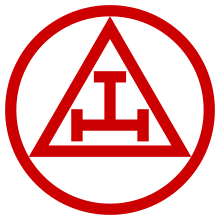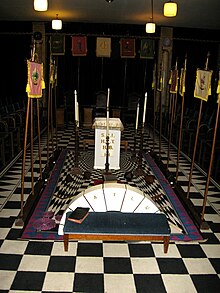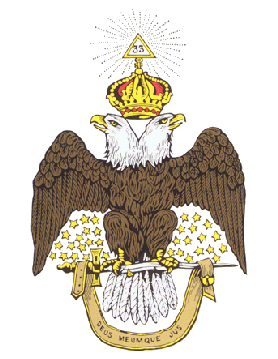|
United States – Scottish Rite of Freemasonry
Virginia Order of the Holy Royal Arch Pin
2017 Metal Pin 22mm x 21mm (4.24 grams)
FRIENDSHIP LEADERSHIP VIRGINIA, Royal Arch Tau within Pyramid, encircled twice, handshake below.
DAN H. SURFACE 2017
You are bidding on the exact item pictured, provided with a Certificate of Authenticity and Lifetime Guarantee of Authenticity.
 The Holy Royal Arch is a degree of Freemasonry. The Royal Arch is present in all main masonic systems, though in some it is worked as part of Craft (‘mainstream’) Freemasonry, and in others in an appendant (‘additional’) order. Royal Arch Masons meet as a Chapter; in the Supreme Order of the Holy Royal Arch as practised in the British Isles, much of Europe and the Commonwealth, Chapters confer the single degree of Royal Arch Mason. The Holy Royal Arch is a degree of Freemasonry. The Royal Arch is present in all main masonic systems, though in some it is worked as part of Craft (‘mainstream’) Freemasonry, and in others in an appendant (‘additional’) order. Royal Arch Masons meet as a Chapter; in the Supreme Order of the Holy Royal Arch as practised in the British Isles, much of Europe and the Commonwealth, Chapters confer the single degree of Royal Arch Mason.
In the British Isles, most of continental Europe (including the masonically expanding states of eastern Europe), and most nations of the Commonwealth (with the notable exception of Canada), the teachings of Royal Arch Masonry are contained in the “Supreme Order of the Holy Royal Arch” – a stand-alone degree of Freemasonry which is open to those who have completed the three Craft degrees. Until 1823, only freemasons who had previously passed through the chair of a Craft lodge were allowed to join. Today, candidates for an English Holy Royal Arch Chapter are required to have been a Master Mason for four weeks or more.
 In Freemasonry in Scotland, the candidate for the Royal Arch must also be a Mark Master Mason, a degree which is part of the Royal Arch series. It can be worked in the Chapter, or more often has been worked in a Scottish Lodge. After the Mark degree, a candidate must receive the Excellent Master degree, before being exalted to the Royal Arch degree. In Ireland a candidate must be a Master Mason for one year before being admitted as a member of a Royal Arch Chapter. The Degree of Mark Master Mason is taken separately first and only then can the Royal Arch Degree be taken. In Freemasonry in Scotland, the candidate for the Royal Arch must also be a Mark Master Mason, a degree which is part of the Royal Arch series. It can be worked in the Chapter, or more often has been worked in a Scottish Lodge. After the Mark degree, a candidate must receive the Excellent Master degree, before being exalted to the Royal Arch degree. In Ireland a candidate must be a Master Mason for one year before being admitted as a member of a Royal Arch Chapter. The Degree of Mark Master Mason is taken separately first and only then can the Royal Arch Degree be taken.
In the United States, Canada, Brazil, Israel, Mexico, Paraguay and the Philippines, the Royal Arch is not worked as a stand-alone degree as described above, but forms part of the York Rite system of additional Masonic degrees. Royal Arch Masons in the York Rite also meet as a Chapter, but the Royal Arch Chapter of the York Rite confers four different degrees: ‘Mark Master Mason’, ‘Virtual Past Master’, ‘Most Excellent Master’, and ‘Royal Arch Mason’. While the York Rite degree of ‘Royal Arch Mason’ is roughly comparable to the Supreme Order of the Holy Royal Arch as practised in England and Wales, the other degrees may have equivalents in other appendant orders.
The Royal Arch is also the subject of the 13th and 14th degrees of the Scottish Rite of Freemasonry (called “Ancient and Accepted Rite” in England and Wales).
Similarly to Craft Freemasonry, the Royal Arch conveys moral and ethical lessons. In the three degrees of the Craft, the candidate is presented with a series of practical principles of service to his fellow man. But as man is not simply a practical being, he also has an essential spiritual aspect to his nature. The Royal Arch further develops this latter aspect by a contemplation of man’s spiritual nature, not replacing but supporting what the candidate has learnt from his own religion. In the Chapter, the teachings of the Royal Arch are conveyed using a ritualised allegory based on the Old Testament telling of the return to Jerusalem from the Babylonian captivity to rebuild the City and Temple. In clearing the ground of Solomon’s Temple for the foundations of a new temple, the candidate makes important discoveries. By adding a further explanation to the practical lessons of Craft Freemasonry, the Royal Arch is seen as an extension of the preceding degrees and the philosophical lessons conveyed are appropriate to that stage in a candidate’s Masonic development. The symbol or Grand Emblem of Royal Arch Masonry is the Triple Tau.
 The Ancient and Accepted Scottish Rite of Freemasonry (the Northern Masonic Jurisdiction in the United States often omits the and, while the English Constitution in the United Kingdom omits the Scottish), commonly known as simply the Scottish Rite (or, in England and Australia, as the Rose Croix although this is only one of its degrees), is one of several Rites of Freemasonry. A Rite is a progressive series of degrees conferred by various Masonic organizations or bodies, each of which operates under the control of its own central authority. In the Scottish Rite the central authority is called a Supreme Council. The Ancient and Accepted Scottish Rite of Freemasonry (the Northern Masonic Jurisdiction in the United States often omits the and, while the English Constitution in the United Kingdom omits the Scottish), commonly known as simply the Scottish Rite (or, in England and Australia, as the Rose Croix although this is only one of its degrees), is one of several Rites of Freemasonry. A Rite is a progressive series of degrees conferred by various Masonic organizations or bodies, each of which operates under the control of its own central authority. In the Scottish Rite the central authority is called a Supreme Council.
The Scottish Rite is one of the appendant bodies of Freemasonry that a Master Mason may join for further exposure to the principles of Freemasonry. It is also concordant, in that some of its degrees relate to the degrees of Symbolic (Craft) Freemasonry. In England and some other countries, while the Scottish Rite is not accorded official recognition by the Grand Lodge, only a recognised Freemason may join and there is no prohibition against his doing so. In the United States, however, the Scottish Rite is officially recognized by Grand Lodges as an extension of the degrees of Freemasonry. The Scottish Rite builds upon the ethical teachings and philosophy offered in the Craft (or Blue) Lodge, through dramatic presentation of the individual degrees.
 Freemasonry or Masonry consists of fraternal organisations that trace their origins to the local fraternities of stonemasons, which from the end of the fourteenth century regulated the qualifications of stonemasons and their interaction with authorities and clients. The degrees of freemasonry retain the three grades of medieval craft guilds, those of Apprentice, Journeyman or fellow (now called Fellowcraft), and Master Mason. These are the degrees offered by Craft (or Blue Lodge) Freemasonry. Members of these organisations are known as Freemasons or Masons. There are additional degrees, which vary with locality and jurisdiction, and are usually administered by different bodies than the craft degrees. Freemasonry or Masonry consists of fraternal organisations that trace their origins to the local fraternities of stonemasons, which from the end of the fourteenth century regulated the qualifications of stonemasons and their interaction with authorities and clients. The degrees of freemasonry retain the three grades of medieval craft guilds, those of Apprentice, Journeyman or fellow (now called Fellowcraft), and Master Mason. These are the degrees offered by Craft (or Blue Lodge) Freemasonry. Members of these organisations are known as Freemasons or Masons. There are additional degrees, which vary with locality and jurisdiction, and are usually administered by different bodies than the craft degrees.
The basic, local organisational unit of Freemasonry is the Lodge. The Lodges are usually supervised and governed at the regional level (usually coterminous with either a state, province, or national border) by a Grand Lodge or Grand Orient. There is no international, worldwide Grand Lodge that supervises all of Freemasonry; each Grand Lodge is independent, and they do not necessarily recognise each other as being legitimate.
Modern Freemasonry broadly consists of two main recognition groups. Regular Freemasonry insists that a volume of scripture is open in a working lodge, that every member profess belief in a Deity, that no women are admitted, and that the discussion of religion and politics is banned. Continental Freemasonry is now the general term for the “liberal” jurisdictions who have removed some, or all, of these restrictions.
|





 The Holy Royal Arch is a degree of Freemasonry. The Royal Arch is present in all main masonic systems, though in some it is worked as part of Craft (‘mainstream’) Freemasonry, and in others in an appendant (‘additional’) order. Royal Arch Masons meet as a Chapter; in the Supreme Order of the Holy Royal Arch as practised in the British Isles, much of Europe and the Commonwealth, Chapters confer the single degree of Royal Arch Mason.
The Holy Royal Arch is a degree of Freemasonry. The Royal Arch is present in all main masonic systems, though in some it is worked as part of Craft (‘mainstream’) Freemasonry, and in others in an appendant (‘additional’) order. Royal Arch Masons meet as a Chapter; in the Supreme Order of the Holy Royal Arch as practised in the British Isles, much of Europe and the Commonwealth, Chapters confer the single degree of Royal Arch Mason. In Freemasonry in Scotland, the candidate for the Royal Arch must also be a Mark Master Mason, a degree which is part of the Royal Arch series. It can be worked in the Chapter, or more often has been worked in a Scottish Lodge. After the Mark degree, a candidate must receive the Excellent Master degree, before being exalted to the Royal Arch degree. In Ireland a candidate must be a Master Mason for one year before being admitted as a member of a Royal Arch Chapter. The Degree of Mark Master Mason is taken separately first and only then can the Royal Arch Degree be taken.
In Freemasonry in Scotland, the candidate for the Royal Arch must also be a Mark Master Mason, a degree which is part of the Royal Arch series. It can be worked in the Chapter, or more often has been worked in a Scottish Lodge. After the Mark degree, a candidate must receive the Excellent Master degree, before being exalted to the Royal Arch degree. In Ireland a candidate must be a Master Mason for one year before being admitted as a member of a Royal Arch Chapter. The Degree of Mark Master Mason is taken separately first and only then can the Royal Arch Degree be taken. The Ancient and Accepted Scottish Rite of Freemasonry (the Northern Masonic Jurisdiction in the United States often omits the and, while the English Constitution in the United Kingdom omits the Scottish), commonly known as simply the Scottish Rite (or, in England and Australia, as the Rose Croix although this is only one of its degrees), is one of several Rites of Freemasonry. A Rite is a progressive series of degrees conferred by various Masonic organizations or bodies, each of which operates under the control of its own central authority. In the Scottish Rite the central authority is called a Supreme Council.
The Ancient and Accepted Scottish Rite of Freemasonry (the Northern Masonic Jurisdiction in the United States often omits the and, while the English Constitution in the United Kingdom omits the Scottish), commonly known as simply the Scottish Rite (or, in England and Australia, as the Rose Croix although this is only one of its degrees), is one of several Rites of Freemasonry. A Rite is a progressive series of degrees conferred by various Masonic organizations or bodies, each of which operates under the control of its own central authority. In the Scottish Rite the central authority is called a Supreme Council. Freemasonry or Masonry consists of fraternal organisations that trace their origins to the local fraternities of stonemasons, which from the end of the fourteenth century regulated the qualifications of stonemasons and their interaction with authorities and clients. The degrees of freemasonry retain the three grades of medieval craft guilds, those of Apprentice, Journeyman or fellow (now called Fellowcraft), and Master Mason. These are the degrees offered by Craft (or Blue Lodge) Freemasonry. Members of these organisations are known as Freemasons or Masons. There are additional degrees, which vary with locality and jurisdiction, and are usually administered by different bodies than the craft degrees.
Freemasonry or Masonry consists of fraternal organisations that trace their origins to the local fraternities of stonemasons, which from the end of the fourteenth century regulated the qualifications of stonemasons and their interaction with authorities and clients. The degrees of freemasonry retain the three grades of medieval craft guilds, those of Apprentice, Journeyman or fellow (now called Fellowcraft), and Master Mason. These are the degrees offered by Craft (or Blue Lodge) Freemasonry. Members of these organisations are known as Freemasons or Masons. There are additional degrees, which vary with locality and jurisdiction, and are usually administered by different bodies than the craft degrees.




